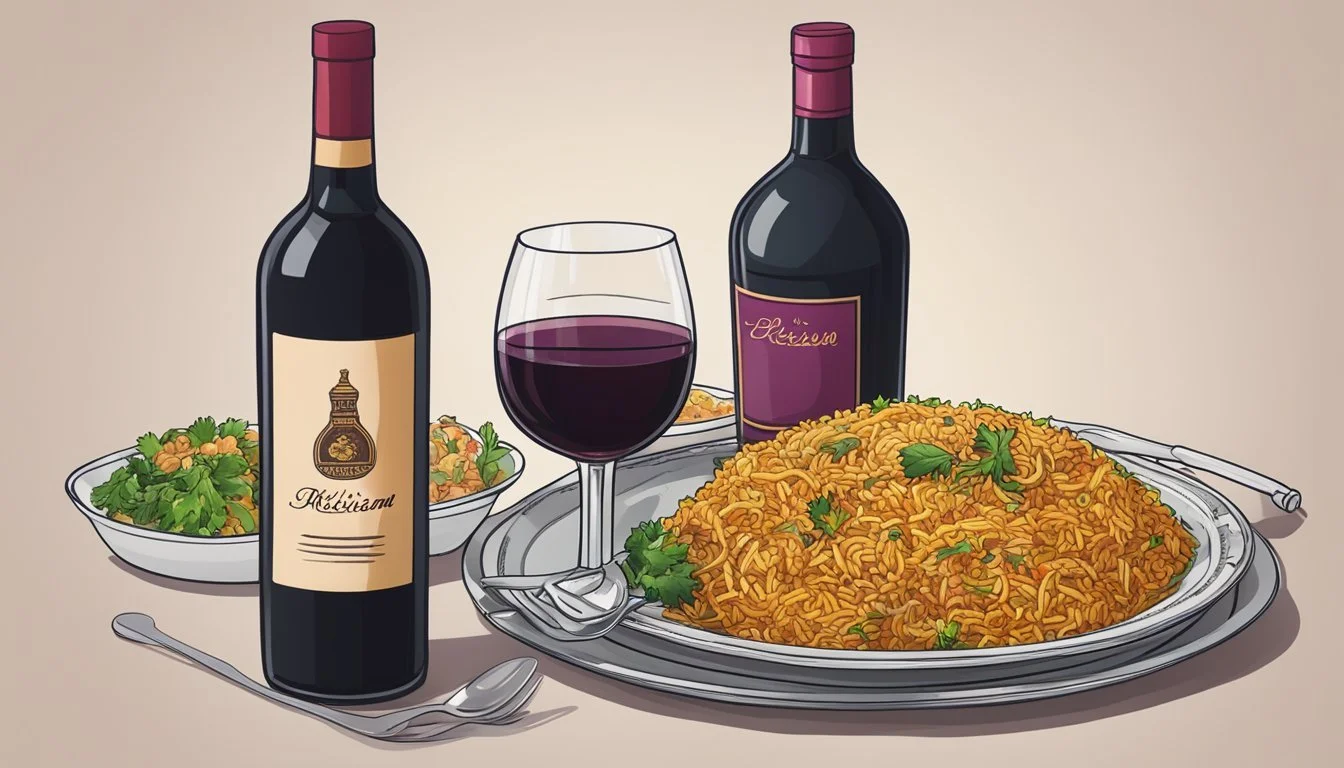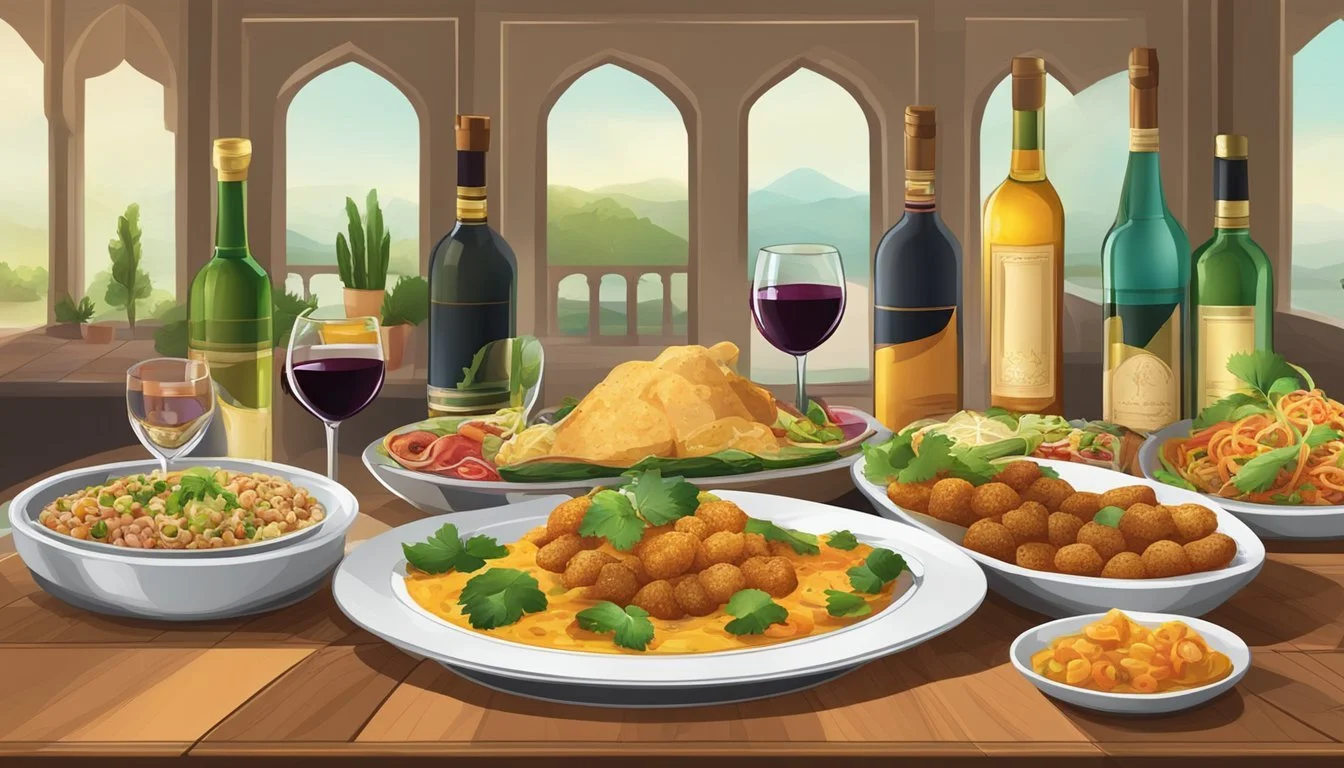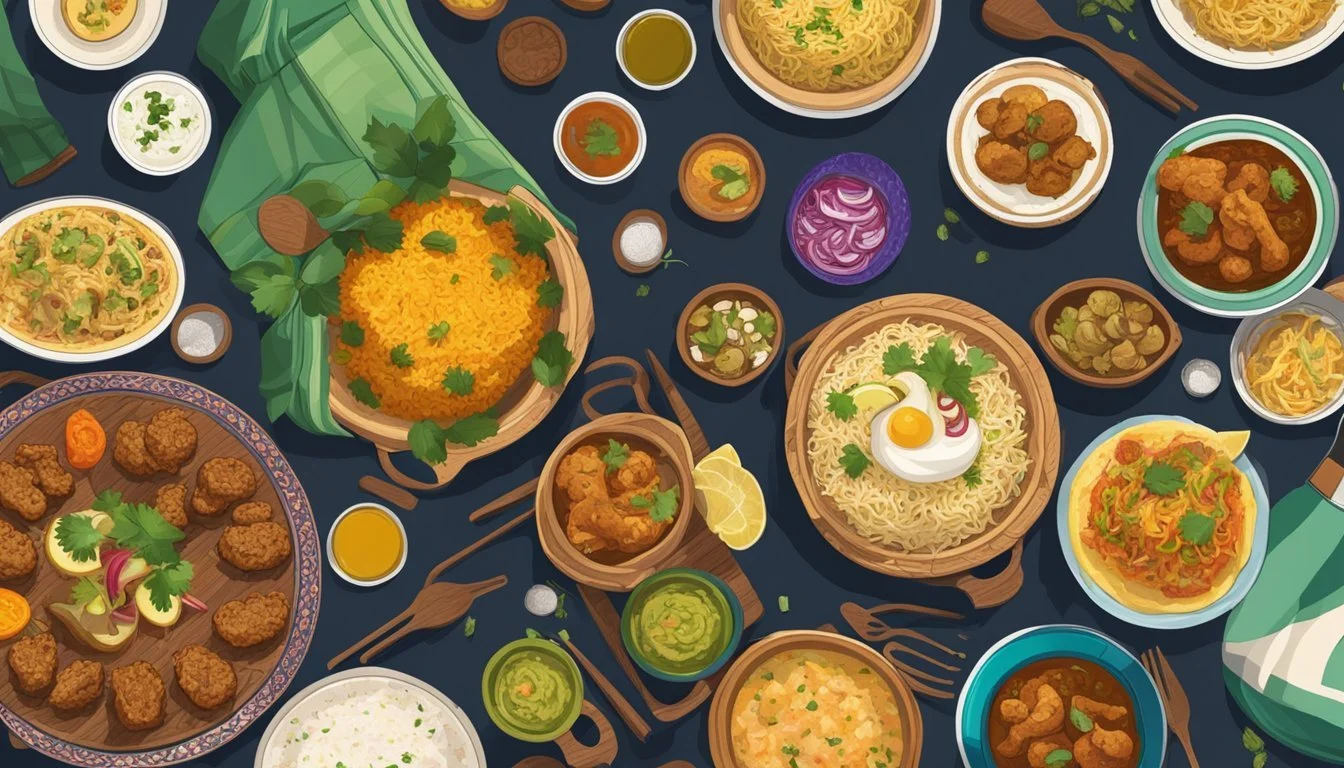What Wine Goes Well with Pakistani Food?
Pairing Tips for an Exquisite Experience
Pakistani cuisine is a complex tapestry of flavors, known for its aromatic spices, vibrant herbs, and combination of textures. It creates a unique challenge for wine pairing, demanding selections that complement the richness and intensity of the dishes. Careful consideration is key to ensure the wine enhances the meal rather than overpower the intricate flavors. The key to a successful pairing lies in balancing the boldness of Pakistani spices with a wine's fruitiness and acidity, so neither element is lost in the culinary experience.
Wine enthusiasts often gravitate towards off-dry Rieslings or Gewürztraminers when faced with spicy foods, (What wine goes well with spicy food?) as their sweetness and acidity can provide a refreshing counterbalance to heat. Aromatic whites are generally reliable companions to the layered flavors in Pakistani dishes. White wines with a slight sweetness help temper the heat and complement the array of spices commonly found in this cuisine.
In contrast to delicate white wines, robust red wines can also find their place at the Pakistani table. Reds with smoother tannins and fruity profiles, such as a ripe Syrah or Grenache, harmonize well with hearty meat dishes that feature rich sauces and grilled flavors. When selecting a wine for a Pakistani meal, one should take into account both the intensity of the spices involved and the primary ingredients of the dish to ensure a harmonious pairing.
Understanding Wine Basics
To pair wine successfully with Pakistani cuisine, one must grasp the foundational elements of wine that influence taste and compatibility with various dishes.
Types of Wine
Wine is commonly categorized into three main types: red wine, white wine, and sparkling wine. Red wines are typically made from dark-colored grape varieties and are known for their bold flavors and tannins. White wines, made from green or yellow grapes, offer a range of tastes from crisp and refreshing to rich and full-bodied. Sparkling wines are carbonated, providing a bubbly texture that can range from sweet Prosecco to dry Champagne.
Exploring Wine Flavors
Wine flavors are often described as either sweet, sour (acidic), or bitter (tannic). Sweet wines can balance heavily spiced Pakistani dishes, while the sour taste from the acidity in wine can act as a palate cleanser. Red wines often introduce a complex blend of both sour and bitter notes, with certain varietals offering fruitier or more earthy flavors.
The Role of Acidity in Wine
Acidity is crucial in wine, as it affects the tartness and freshness. High acidity wines, such as Sauvignon Blanc or Riesling, can complement creamy or richly flavored Pakistani foods (What wine goes well with Pakistani food?), as the acidity cuts through the fat and balances the meal. Meanwhile, wines with lower acidity might taste flabby or less vibrant when paired with robust cuisines.
Aroma Profiles in Wine
Aroma plays a significant part in the wine drinking experience. Aromatic compounds contribute to the scents that can be fruity, floral, herbal, or even earthy. The aroma profile of a wine can enhance the dining experience when paired well with the aromatic spices used in Pakistani cooking. For instance, a wine with a fruity aroma can contrast pleasantly with a spicy curry.
Wine Body and Structure
The body of a wine refers to its weight or fullness in the mouth, ranging from light to full-bodied. Full-bodied red wines like Cabernet Sauvignon are rich and complex, often pairing well with hearty meat dishes. White wines, on the other hand, can range from light, such as Pinot Grigio, to full-bodied like an oak-aged Chardonnay, which can stand up to spicy and flavorful dishes.
Specific Wines and Their Characteristics
Selecting the appropriate wine to accompany Pakistani cuisine involves understanding the flavor profiles of both the food and the wine. Spice-driven dishes with hearty meats and aromatic herbs call for wines that can match their intensity without overwhelming the palate.
Noteworthy White Wines
Riesling: A versatile wine that comes in both dry and off-dry styles. Its natural acidity and stone fruit flavors make it an excellent match for the aromatic spices found in Pakistani dishes.
Gewürztraminer: Known for its bold lychee and rose petal aromas, Gewürztraminer can bring out the complexity of Pakistani flavors, especially in dishes that contain ginger and clove.
Sauvignon Blanc: This wine's crisp acidity and citrus notes offer a refreshing contrast to the rich, savory flavors of Pakistani curries.
Chenin Blanc: With its balanced acidity and ability to range from dry to sweet, Chenin Blanc pairs well with both the mild and spicy dishes (What wine goes well with spicy dishes?) of Pakistani cuisine.
Popular Red Wines
Pinot Noir: The light-bodied nature and red fruit aromas of Pinot Noir make it a red wine that can stand up to a variety of Pakistani dishes without obscuring flavors.
Syrah/Shiraz: Offering bold flavors of dark fruit and spice, Syrah or Shiraz complements the robust flavors of grilled meats and barbecued dishes prevalent in Pakistani food.
Grenache: A fruit-driven red wine that highlights raspberry and cherry notes, Grenache can be an exceptional pairing with kebabs and other meat-centric dishes.
Malbec: Known for its plummy flavor profile and smooth tannins, Malbec supports the richness of meat dishes while adding a fruity complexity.
Specialty Wines and Regions
Champagne: The effervescence and acidity of Champagne cut through the richness of fried items like samosas, providing a balanced taste experience.
Rosés: Ranging from dry to sweet, rosés offer a versatility that works well with the varied spice levels in Pakistani cuisine, making them a safe and appealing choice.
Albariño: With its pronounced minerality and high acidity, Albariño is an excellent white wine choice for seafood (What wine goes well with seafood?) and lighter Pakistani fares.
Torrontés: This Argentinean white wine, which is aromatic with notes of peach and apricot, goes well with mildly spiced Pakistani dishes and can stand up to the gusto of bolder flavors.
Pairing Wine with Pakistani Cuisine
When it comes to pairing wine with Pakistani cuisine, one must consider the balance of spices and the intensity of flavors that characterize this rich, culinary tradition.
Matching Intensity and Spice
Pakistani cuisine is known for its bold spice profiles, featuring elements like pepper, ginger, and coriander. To match the intensity and spice, wines with good acidity and a touch of sweetness can help balance the palate. A Riesling, especially off-dry, can be an excellent choice. It’s high acidity and fruit-forward profile complements the heat without overpowering the dish. For dishes with milder spiciness, a Grenache with its fruity notes can harmonize well with the flavors.
Wine for Hearty Pakistani Dishes
Many traditional Pakistani dishes are hearty, often featuring beef or mutton, and are typically accompanied by rich sauces. When selecting wine for these robust dishes, one should look for full-bodied reds. A Syrah, recognized for its peppery notes, stands up to the savory tastes and complements barbecue elements commonly found in the cuisine. Alternatively, a full-bodied Malbec can pair well with the beef-centric dishes due to its dark fruit flavors and smoky finish.
Wines with Aromatic Pakistani Food
Pakistani cuisine is also aromatic, layered with spices such as global Muslim/oxtail masala. To pair with the fragrant and sometimes delicate flavors, one might consider a Viognier. This wine carries its own aromatic profile that can enhance the sensory experience of the dish. For seafood options, a lighter white wine like Pinot Grigio can offer a crisp, refreshing contrast to the aromatic spices, supporting the dish without overwhelming it.
Selecting Wines for Popular Pakistani Dishes
Selecting the right wine to pair with Pakistani dishes can enhance the dining experience, as the complex flavors of the cuisine are complemented by the wine's character. Whether one is enjoying a rich meat dish, a vegetarian fare, or a seafood delight, the interplay of spices, aromas, and tastes becomes pivotal in choosing the right wine.
Wine for Rich Meat Dishes
Pakistani meat dishes, often rich and barbecue-flavored, call for wines that can stand up to hearty flavors. Robust red wines with a good tannic structure or fruity undertones complement the smoky and spicy profiles of dishes containing beef or lamb.
Beef Kebabs or Tikka: A medium-bodied Zinfandel, with its bold fruit flavors, can balance the spice while the subtle smoky notes resonate with the barbecue aroma.
Mutton Curry: For a spicy mutton curry, a Shiraz with notes of black pepper and dark fruit not only matches the heat but enhances the earthy spices.
Wine Pairings for Vegetarian Fare
Pairs for vegetarian dishes (What wine goes well with vegetarian dishes?) should balance the aromatic spices without overpowering the often delicate flavors. Off-dry white wines can provide a refreshing contrast, offsetting both the spiciness and the savory aspects of the cuisine.
Palak Paneer: An off-dry Riesling with hints of sweetness cuts through the dish's heat and complements its creaminess.
Vegetable Biryani: A Viognier, known for floral aromas and stone-fruit flavors, pairs harmoniously with the perfume of basmati rice and mixed vegetables.
Ideal Wines for Seafood in Pakistani Cuisine
Seafood in Pakistani cuisine is typically prepared with an array of spices and may carry a slight heat. White wines, especially those with good acidity, are perfect for accentuating the flavors of the sea without diminishing the impact of the spices.
Grilled Fish: A crisp Sauvignon Blanc, noted for its acidity, enhances the flavors without overwhelming the subtle taste of the fish.
Prawn Curry: A full-bodied Chardonnay with a touch of oak can stand up to the richness of the curry while integrating well with the seafood's sweet nuances.
Regional Wine Variations and Their Pairings
In the diverse landscape of wines, certain regional variations are particularly well-suited to complement the complex flavors found in Pakistani cuisine. From the traditional Old World wines to the vibrant New World contenders, there is a rich array of options to enhance the dining experience.
Old World Wines
Old World wines, particularly those from France and Italy, bring a history of winemaking that often pairs well with the rich and hearty flavors of Pakistani meat dishes. A robust Chianti from Tuscany, with its high acidity and cherry notes, is excellent with tomato-based curries, while the earthy and complex Merlot blends of Bordeaux, France, can complement the spice-laden dishes of the region.
Recommended Pairings:
Chianti: Tomato-based curries, grilled kebabs
Bordeaux: Nihari (slow-cooked beef stew), (What wine goes well with beef stew?) Haleem (stew with lentils and meat)
New World Rising Stars
Emerging players like Argentina and Chile are producing vibrant New World wines that are gaining popularity for their versatility with diverse cuisines, including South Asian. An Argentine Malbec, with its dark fruit flavors and smoky finish, is suited for grilled meats and robust stews. Chilean wine from the house of Concha y Toro, on the other hand, offers options like Carménère, which pairs nicely with the aromatic spices found in biryanis.
Suggested Varietals:
Malbec: Spiced grilled meats, hearty stews
Carménère: Biryani, chargrilled vegetables
Spotlight on Regional Wine Heroes
Each region has its heroes, and the Barossa Valley in Australia is home to some of the most delicious Shiraz. These wines are recognized for their ability to hold up to the intense flavors of Pakistani food, such as the rich, slow-cooked meat dishes and the use of bold spices like cumin and cardamom. Similarly, the Tempranillo from Spain with its savory qualities can enhance the flavors of dishes like Daal and mixed vegetable curries.
Highlighted Wines:
Barossa Shiraz: Spicy meat curries, Roghan Josh
Tempranillo: Daal, mixed vegetable curries
The Winemaker's Perspective
In the quest for the perfect food and wine pairing, winemakers weigh in with valuable insights, particularly when it comes to the robust flavors of Pakistani cuisine.
Expert Opinions on Food and Wine Pairing
Winemakers acknowledge the complexity of pairing wines with Pakistani dishes, which are renowned for their vibrant spices and heat. They recommend wines that offer a counterbalance to the intense flavors. Aromatic whites such as Riesling and Gewürztraminer are frequently highlighted for their ability to complement spicy foods. Their natural sweetness and pronounced fruit flavors can soothe the palate, providing a harmonious contrast to dishes laced with spices like cumin, cardamom, and hot chilies. In terms of acidity, winemakers prefer wines with a higher acid profile to cut through the richness of ghee-laden dishes and cleanse the palate.
Wine Selection Tips from Sommeliers
Sommeliers, with their specialized knowledge, advise on selecting wines that enhance the dining experience. When it comes to Pakistani fare, they suggest seeking out wines that are not overly tannic, as these can clash with the cuisine's spice profile. Instead, they point towards medium-bodied reds with softer tannins, like a Syrah or Zinfandel, which can stand up to the bold flavors without overpowering them. Another tip from sommeliers is to pay attention to the wine's sweetness level. A slightly sweet wine can balance the heat in dishes such as curries or kebabs, while a dry, acidic white wine can complement lighter, herb-infused recipes. They specifically note that a chef's use of spices and marination techniques can dramatically affect the taste of a dish, thereby influencing the choice of wine.
Serving and Enjoying the Pairing
When serving wine with Pakistani food, it's essential to consider the temperature, the decanting process, and proper glassware to enhance the flavors of both the wine and the dishes. The sensory experience of tasting wine with food should be deliberate and attentive, allowing for a full appreciation of the pairing.
Wine Serving Temperatures
The correct serving temperature for wine can greatly influence its taste and the way it pairs with food. Here's a brief guide:
Sparkling wines should be served well-chilled, between 6-10°C (43-50°F), to preserve their characteristic freshness and effervescence.
White wines vary in the ideal temperature range:
Lighter, more acidic whites are best served at 7-10°C (45-50°F).
Full-bodied whites with more sugar content should be slightly warmer, at 10-13°C (50-55°F), to bring out their complex flavors.
Red wines should be slightly below room temperature:
Light-bodied reds with higher acidity can be enjoyed at 12-15°C (54-59°F).
Full-bodied reds need a bit more warmth, around 15-18°C (59-64°F), to fully express their structure and boldness.
Decanting and Glassware Recommendations
Decanting and the choice of glassware can enhance the wine's interaction with Pakistani cuisine:
Decanting:
Full-bodied red wines often benefit from decanting to allow them to breathe and soften, which can balance the hearty spices and robust flavors in Pakistani dishes.
Lighter-bodied whites or reds typically do not need decanting but ensuring they are properly aerated in the glass can enhance their freshness and aromatic profile.
Glassware:
Sparkling wines should be served in flutes to retain their carbonation and showcase their delicate aromas.
White wines require a glass with a narrower bowl to concentrate the floral and fruity aromas.
Red wines perform best in a glass with a wider bowl to allow for aeration, softening tannins, and intensifying the complexity of the wine.
The Art of Tasting Wine with Food
Tasting wine with Pakistani food is an artful experience driven by attention to how elements like sweetness, acidity, and body interact:
Assess the body of the wine; robust Pakistani dishes typically pair well with full-bodied wines that match their intensity.
Acidity in wine can cut through richness and refresh the palate, making it a suitable contrast to creamy or fatty foods.
A touch of sweetness in a wine, such as an off-dry Riesling or Chenin Blanc, can complement the spiciness of Pakistani cuisine, providing a pleasant balance to the heat.
Sip the wine and then take a bite of the food, noting how the flavors evolve together. The right pairing will result in a harmonious balance, where neither the wine nor the food overwhelms the other.
Conclusion and Recommendations
When pairing wine with Pakistani cuisine, the key is to consider the rich tapestry of flavors and spices. These dishes commonly feature a spectrum of heat levels and aromatic spices, necessitating a careful wine selection to enhance both the food and wine experience.
White Wines: For dishes with milder spices and herbs, a Riesling or Gewürztraminer can complement the flavors due to their good acidity and fruit-forward nature. They counterbalance the heat while amplifying subtle spices.
Wine Type Dish Type Reason Riesling Lightly spiced dishes High acidity, sweet Gewürztraminer Aromatic, spiced dishes Bold, floral aromas
Red Wines: If the cuisine is rich and robust, a light-bodied red like Pinot Noir with its subtle earthiness can provide a harmonious balance. For meat-heavy dishes with bold flavors, a Syrah, known for its peppery notes, may stand up well to the challenge.
Wine Type Dish Type Reason Pinot Noir Mild meat dishes Light-bodied, earthy Syrah Hearty stews Full-bodied, peppery
Rosé and Sparkling Wines: They should not be overlooked, because their versatility can cut through the richness of spiced food, cleanse the palate, and offer a refreshing contrast.
In summary, the effervescence and acidity in wines like Rosés and certain sparkling varieties serve to cleanse the palate. When dealing with spicy foods, wines with a hint of sweetness can offset the heat and marry well with complex spices. Always consider the intensity of both the wine and the dish to avoid one overpowering the other. Remember that personal preference should guide the final pairing choice.
Appendix
The Appendix provides readers with a deeper understanding of common terms used in wine and food pairing, as well as resources for further exploration on pairing wine with Pakistani cuisine.
Glossary of Wine and Food Pairing Terms
Acidity: The liveliness and crispness in wine that can be felt on the palate. In food pairing, acidity should match the acidity level in the dish.
Body: Refers to the weight and fullness of wine on the palate. Wines can be light-bodied, medium-bodied, or full-bodied, with heavier foods generally requiring a wine with more body.
Tannins: Found primarily in red wines, tannins contribute to the dryness and bitterness of the wine. They can interact with fatty and rich foods to create a balanced taste sensation.
Residual Sugar: The amount of sugar remaining in wine after fermentation. Wines with higher residual sugar can pair well with spicy Pakistani dishes, as the sweetness can offset heat.
Finish: The lingering flavor of the wine after it has been swallowed. A longer finish can complement complex, flavorful dishes.
References and Further Reading
Wine and Food Pairing Guidebooks: Specific titles such as "Food and Wine Pairing: A Sensory Experience" provide an in-depth look at the principles of pairing.
Online Resources: Websites like Wine Folly offer charts and articles with pairing suggestions that are easily accessible and informative.
Cultural Cuisine Guides: Exploring books that focus on Pakistani cuisine can give insights into traditional flavors, which is vital for successful wine pairing.









